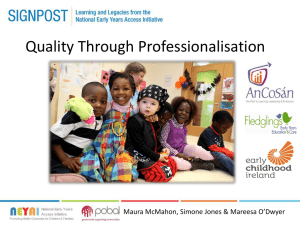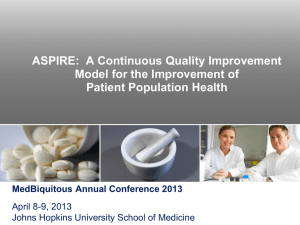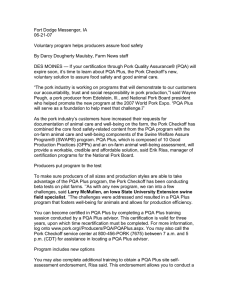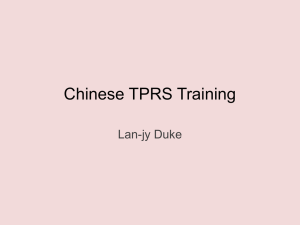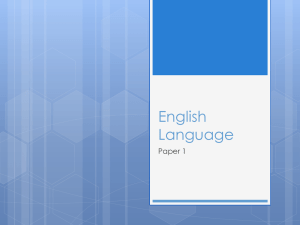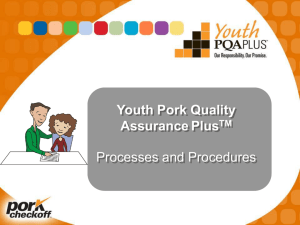Preschool Quality Assessment ppt - Home
advertisement
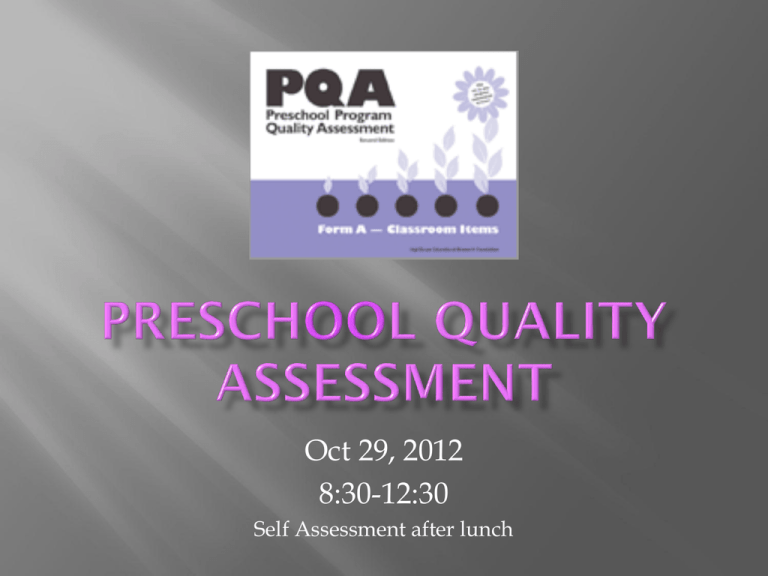
Oct 29, 2012 8:30-12:30 Self Assessment after lunch 8:30 Welcome and review Agenda What is the PQA PQA Statewide Data Report 2008-09, 2009-10 (Mid Year Report) Michigan’s roadmap to Early Care and Education Program Quality Improvement (Paris) Descriptor scramble handout Pages 1-7 in small groups Steps for completing the PQA handout Page 8-11 Scoring the PQA HO Page 11-14/ page 4 of PQA Booklet Break Uses for the PQA HO Page 15 Plan for improvement HO page 16-20 PQA Implementation Plan Classroom based on self evaluation and ECS Local school – based on several classrooms in a school WMISD Consortium PQA Goal A- Improve Small Group Instruction (2010) PQA Goal B- Increase membership in early childhood professional organizations (2010) Dec 3 set goals for WMISD GSRP Consortium (10-12) Look at Program Evaluation Plan for GSRP Online PQA instruction - get computers and start your own after lunch break Questions and Answers/ Evaluations for AM session Lunch Break Return after lunch and complete the PQA Self Assessment on line In order to evaluate and understand children's performance and progress, we need to measure the educational experiences that the programs they attend are providing. Programs, rather than children, should be held accountable for learning. To help programs meet these obligations, educators need valid tools to assess how well their programs promote learning in all areas of development. Valid assessment instruments can guarantee that we are looking at the right ingredients of quality. They give us the information to evaluate whether we are achieving appropriate levels of quality, and if not, where and how we can improve. HighScope has comprehensive program quality assessment tools for the preschool and youth levels. High Scope -http://www.highscope.org/Content.asp?ContentId=79 Program quality, like child development, has many dimensions. It includes: Structural components — the classroom: how the learning environment is set up and what happens during the program day. Process — how adults interact with children and plan and carry out meaningful learning experiences. Ways in which staff relate to parents, one another, and the community can affect children and are part of the quality process. Finally, agency-wide factors influence what happens in the classroom and directly or indirectly impact children. The Preschool Program Quality Assessment (PQA) is a rating instrument designed to evaluate the quality of early childhood programs and identify staff training needs. The Preschool PQA is reliable and valid and is appropriate for use in all center-based early childhood settings, including but not limited to those using the High Scope educational approach. The Preschool PQA is an all-in-one program evaluation system with the following features: Assesses key aspects of program quality Reflects research-based and field-tested best practices in early childhood education and care Can be aligned with the Head Start Program Performance Standards Provides reliable, scientifically validated assessment proven in a wide range of early childhood programs and settings Can be used as a basis for program accreditation, reporting, monitoring, and training Program Quality Assessment (PQA) Appropriate for use in all center-based settings Research – based and field-tested Comprehensive tool Administered by independent evaluators or used as a self- assessment tool Defines quality along a continuum Individual sections can be used to focus on program components Examples can illustrate best practice Providing specific implementation strategies Identify areas for further development and training Quality control for single & multiple sites Objective and quantitative Provides a numerical and anecdotal record of progress Used to acknowledge strengths Identify areas for improvement Develop a plan of action (goals) Documentation Comparison Evaluation Effective tool to share information with parents, agencies, funders and public Information about the PQA can be easily communicated & disseminated Great Start to Quality Northwest Resource Center Paris Philo Quality Improvement Consultant Each item begins with a statement followed by a series of indicators defining the lower, middle and upper ends of the 5-pont quality continuum or rubric. Divided into 7 sections Room arrangement diagram page Daily routine page Series of indicator rows Space to record anecdotal notes Final Score for each item is at top of page Summary score sheet at the end of each form ( classroom & agency- level) Based on Sound Principles of a High Quality Preschool Classroom and 40 years of research in the Perry Preschool Project http://www.highscope.org/Content.asp?ContentId=219 Ypsilanti, MI PQA Describes a high quality preschool program Annual GSRP Mid Year Reports Reporting risk factors Reporting staff qualifications Reporting PQA statewide data www.michigan.gov/gsrp Look for commonalities in the statewide data to our local data – Venn Diagram View preschool video clips Take non judgmental and non biased anecdotal notes on exactly what you – sticky notes See Hear They say/ quotes Activity- Chart what you notice about the 2 clips Categorize by learning environment/ daily routine/ adult child interaction/ curriculum, planning, instruction Read the across the rows Decide what level each descriptor represents Place a #1, 3 or 5 by the indicators in the box Complete pages 1-7 of handout Step 1: Observe. Record supporting evidence. Step 2: Read each row of descriptors and check one box per row Step 3: Circle the corresponding level (1, 2, 3, 4, or 5) Pages 8-11 of Handout Review Page 4 of PQA Booklet – Scoring Guide Video Clips of Preschool Classrooms http://www.highscope.org/Content.asp?ContentId=381 Adult Child Interaction – “Eating Snakes” Small Group Time- “Using Pipe Cleaners and Paper Clips” Recall/ Planning - “Talking with the Caterpillar” Large Group Time – “Singing Punchinello” Observe- Take Anecdotal Notes – Write in the PQA booklet Score the anecdotes, discuss scores Self Assessment Supervision , Observation & Feedback Research and Evaluation Handout -page 15 Identify the item you’d like to improve Choose II-K or V-G (P. 17) With a partner come up with a plan for improvement (P. 18 or 19) Share your plans Handout P. 16-20 GSRP – 3 times per year Self Evaluation in Fall Fall PQA observation with goal setting Follow up with Goal Setting, support, coaching Follow up visit by Administration and Early Childhood Specialist Formal PQA Observation in Spring by Early Childhood Specialist- for MDE/ GSRP office Online PQA home http://www.onlinepqa.net/ Webinar http://www.onlinepqa.net/Default.aspx?id=18 Moving from Good to Great! Developing High Quality Learning Environments for all children!
